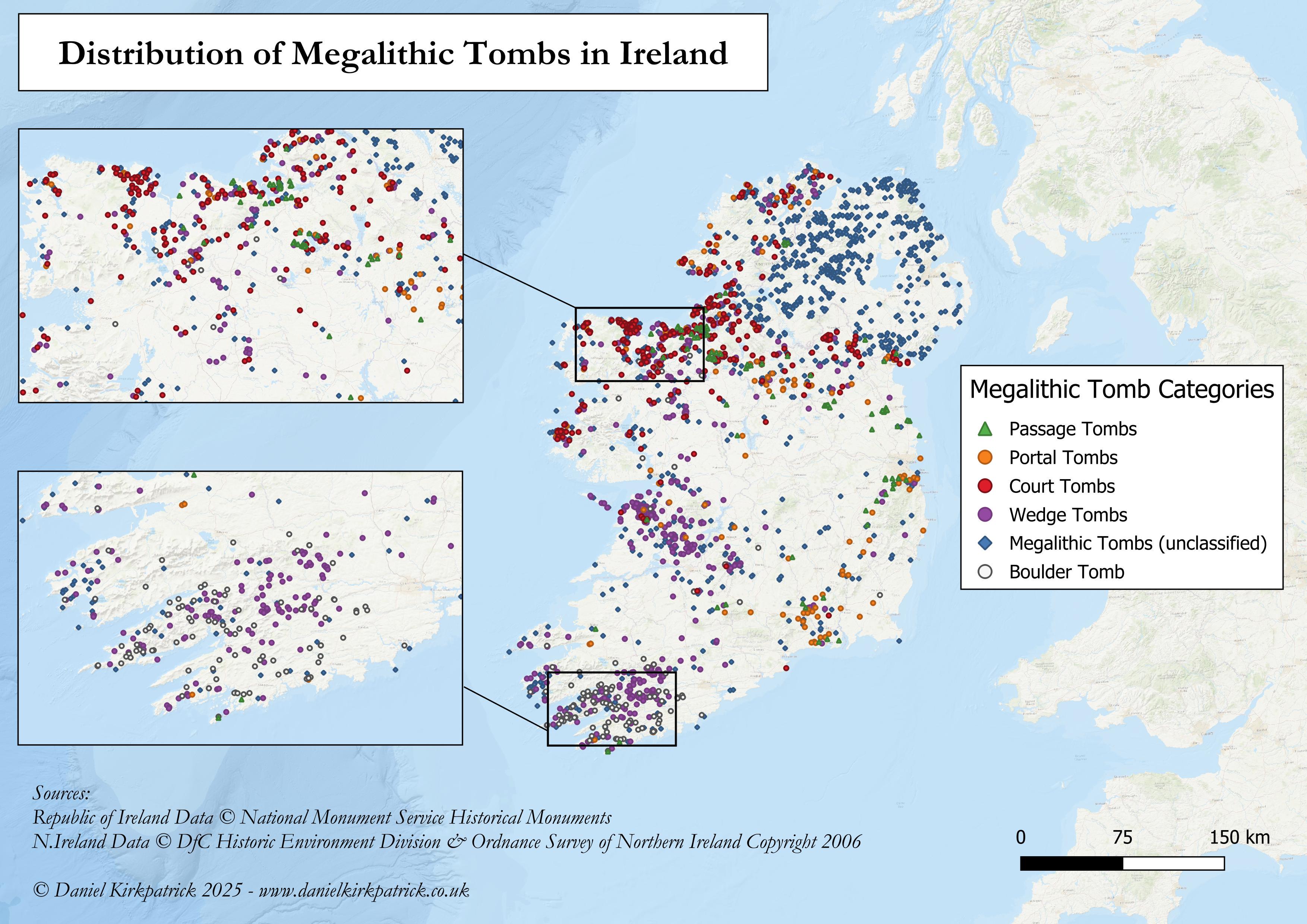Megalithic Tombs Distribution Map of Ireland


Alex Cartwright
Senior Cartographer & GIS Specialist
Alex Cartwright is a renowned cartographer and geographic information systems specialist with over 15 years of experience in spatial analysis and data...
Geographic Analysis
What This Map Shows
The map titled "Distribution of Megalithic Tombs in Ireland" provides a comprehensive visualization of all recorded megalithic tombs scattered across the island. This includes data from both the Republic of Ireland and Northern Ireland, sourced from the National Monument Service (NMS) and the Department for Communities. As you explore the map, you'll notice distinct clusters of various types of tombs, particularly Wedge and Boulder Tombs concentrated in the southwestern regions of the Republic. This visual aid not only highlights the geographical spread of these ancient structures but also serves as a gateway to understanding Ireland's rich prehistoric culture.
Deep Dive into Megalithic Tombs
Megalithic tombs are among the most significant remnants of Ireland's prehistoric past, reflecting the complex societies that thrived thousands of years ago. The term 'megalith' derives from the Greek words "mega" (great) and "lithos" (stone), aptly describing the massive stones used in these structures. They are typically categorized into several types, including passage tombs, portal tombs, wedge tombs, and court tombs, each with unique architectural features and cultural significance.
Passage tombs, such as the famed Newgrange, date back to around 3200 BC, making them older than Stonehenge and the Egyptian pyramids. These structures are characterized by long passageways leading to a central chamber, often adorned with intricate carvings. Interestingly, many passage tombs align with astronomical events, particularly the winter solstice, suggesting that they held significant cosmological importance for the societies that built them.
On the other hand, portal tombs, easily recognizable by their large capstones supported by upright stones, were typically used for burial purposes. Wedge tombs, which taper towards the back and are often found in clusters, are primarily located in the southern regions of Ireland, as highlighted in your map. Each type of tomb provides insights into the burial practices, social structures, and spiritual beliefs of ancient populations.
Interestingly, the distribution of these tombs is not random. The dense concentration of Wedge and Boulder Tombs in the southwest suggests that this region played a pivotal role in the funerary practices of ancient communities. Researchers theorize that the geography, including fertile lands and access to resources, may have influenced these early societies to establish their burial sites in these areas for both practical and symbolic reasons.
Regional Analysis
Taking a closer look at the map, we can identify notable regional variations in the distribution of megalithic tombs. In the southwest, counties like Kerry and Cork are rich in Wedge Tombs, which are often found in mountainous terrains. This geographical feature may have offered a sense of security or a connection to the spiritual world for those who buried their dead in these areas.
Conversely, the eastern regions, particularly around counties Meath and Dublin, showcase a higher prevalence of passage tombs. This aligns with the historical significance of these areas, as they were at the heart of ancient Irish kingdoms. Sites like Knowth and Newgrange not only served as burial sites but also as ceremonial centers, drawing people from distant regions for communal rituals.
Interestingly, Northern Ireland presents a different picture. While it lacks the categorical breakdown seen in the Republic, the overall distribution still reveals a concentration of megalithic sites, especially in counties Antrim and Down. This suggests that the cultural practices surrounding death and burial were significant across the entire island, transcending political boundaries.
Significance and Impact
Understanding the distribution of megalithic tombs in Ireland is crucial for several reasons. Firstly, these sites represent a tangible connection to Ireland's ancient history, offering insights into the lives of our ancestors. The architectural sophistication of these tombs indicates advanced societal organization and cultural values centered around death and the afterlife.
Moreover, the study of megalithic tombs can inform us about the social dynamics of prehistoric communities. For instance, the variation in tomb types and their locations may reflect differing regional beliefs or practices. As we continue to investigate these ancient sites, we also gain a better understanding of Ireland's cultural heritage, which remains an integral part of its identity today.
Current trends in archaeology and heritage management emphasize the importance of preserving these ancient structures. As tourism increases, the need to protect these sites from environmental degradation and human impact becomes ever more urgent. Future projections indicate that with increased awareness and conservation efforts, these megalithic tombs can continue to be a source of knowledge and inspiration for generations to come.
In conclusion, the distribution of megalithic tombs across Ireland is not just a matter of geography; it is a reflection of the ancient cultures that shaped the landscape. By engaging with this map, we not only appreciate the beauty of these structures but also honor the legacy of those who built them.
Visualization Details
- Published
- August 19, 2025
- Views
- 142
Comments
Loading comments...